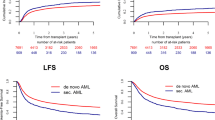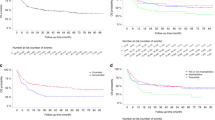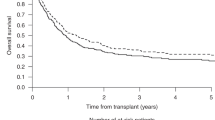Abstract
Secondary malignancies are well established complication in long-term survivors after allogeneic stem-cell transplantation (SCT) with myeloablative conditioning (MAC). Fludarabine-based reduced-intensity (RIC) and reduced-toxicity conditioning (RTC) regimens are increasingly used in the last decade; however, due to limited long-term follow-up, there is no data on secondary malignancies in this setting. The records of 931 consecutive patients given allogeneic SCT with MAC (n=257), RIC (n=449) or RTC (n=225), in a single institution over a 13-year period, were reviewed. Twenty-seven patients had secondary malignancy, diagnosed a median of 43 months (7 months–11.5 years) after SCT. The 10-year cumulative incidence was 5.6% (95% confidence interval (CI), 3.6–8.7), twice the expected rate in matched normal population. The incidence was 1.7, 7.4 and 5.7% after MAC, RIC and RTC, respectively (P=0.02). Multivariate analysis identified fludarabine-based conditioning (hazard ratio (HR) 3.5, P=0.05), moderate–severe chronic graft-versus-host disease (HR 2.8, P=0.01) and diagnosis of chronic myeloproliferative or non-malignant disease (HR 0.2, P=0.04) as risk-factors for secondary malignancy. The related 10-year mortality rate was 2.4% (95% CI, 1.0–5.4). In conclusion, the risk of secondary malignancies is not reduced and is even possibly increased in the era of fludarabine-based RIC/RTC. Patients and physicians should be aware of this association and life-long cancer screening is required for all transplant survivors.
This is a preview of subscription content, access via your institution
Access options
Subscribe to this journal
Receive 12 print issues and online access
$259.00 per year
only $21.58 per issue
Buy this article
- Purchase on Springer Link
- Instant access to full article PDF
Prices may be subject to local taxes which are calculated during checkout


Similar content being viewed by others
References
Gooley TA, Chien JW, Pergam SA, Hingorani S, Sorror ML, Boeckh M et al. Reduced mortality after allogeneic hematopoietic-cell transplantation. N Engl J Med 2010; 363: 2091–2101.
Wingard JR, Majhail NS, Brazauskas R, Wang Z, Sobocinski KA, Jacobsohn D et al. Long-term survival and late deaths after allogeneic hematopoietic cell transplantation. J Clin Oncol 2011; 29: 2230–2239.
Curtis RE, Rowlings PA, Deeg HJ, Shriner DA, Socíe G, Travis LB et al. Solid cancers after bone marrow transplantation. N Engl J Med 1997; 336: 897–904.
Kolb HJ, Socié G, Duell T, Van Lint MT, Tichelli A, Apperley JF et al. Malignant neoplasms in long-term survivors of bone marrow transplantation. Late effects working party of the European Cooperative Group for Blood and Marrow Transplantation and the European Late Effect Project Group. Ann Intern Med 1999; 131: 738–744.
Bhatia S, Louie AD, Bhatia R, O’Donnell MR, Fung H, Kashyap A et al. Solid cancers after bone marrow transplantation. J Clin Oncol 2001; 19: 464–471.
Gallagher G, Forrest DL . Second solid cancers after allogeneic hematopoietic stem cell transplantation. Cancer 2007; 109: 84–92.
Curtis RE, Metayer C, Rizzo JD, Socié G, Sobocinski KA, Flowers ME et al. Impact of chronic GVHD therapy on the development of squamous-cell cancers after hematopoietic stem-cell transplantation: an international case-control study. Blood 2005; 105: 3802–3811.
Rizzo JD, Curtis RE, Socié G, Sobocinski KA, Gilbert E, Landgren O et al. Solid cancers after allogeneic hematopoietic cell transplantation. Blood 2009; 113: 1175–1183.
Majhail NS, Brazauskas R, Rizzo JD, Sobecks RM, Wang Z, Horowitz MM et al. Secondary solid cancers after allogeneic hematopoietic cell transplantation using busulfan-cyclophosphamide conditioning. Blood 2011; 117: 316–322.
Champlin R, Khouri I, Shimoni A, Gajewski J, Kornblau S, Molldrem J et al. Harnessing graft-versus-malignancy: non-myeloablative preparative regimens for allogeneic haematopoietic transplantation, an evolving strategy for adoptive immunotherapy. Br J Haematol 2000; 111: 18–29.
Shimoni A, Shem-Tov N, Volchek Y, Danylesko I, Yerushalmi R, Nagler A . Allogeneic stem-cell transplantation for AML and MDS with treosulfan compared with busulfan-based regimens; Reduced toxicity Vs. reduced intensity. Bone Marrow Transplant 2012; 47: 1274–1282.
Gooley TA, Leisenring W, Crowley J, Storer BE . Estimation of failure probabilities in the presence of competing risks: new representations of old estimators. Stat Med 1999; 18: 695–706.
Kaplan EL, Meier P . Nonparametric estimation from incomplete observations. J Am Stat Assos 1958; 53: 457–481.
Allan JM, Travis LB . Mechanism of therapy-related carcinogenesis. Nat Rev Cancer 2005; 5: 943–955.
Themeli M, Petrikkos L, Waterhouse M, Bertz H, Lagadinou E, Zoumbos N et al. Alloreactive microenvironment after human hematopoietic cell transplantation induces genomic alterations in epithelium through an ROS-mediated mechanism: in vivo and in vitro study and implications to secondary neoplasia. Leukemia 2010; 24: 536–543.
Savani BN, Stratton P, Shenoy A, Kozanas E, Goodman S, Barrett AJ . Increased risk of cervical dysplasia in long-term survivors of allogeneic stem cell transplantation—implications for screening and HPV vaccination. Biol Blood Marrow Transplant 2008; 14: 1072–1075.
Gandhi V, Plunkett W . Cellular and clinical pharmacology of fludarabine. Clin Pharmacokinet 2002; 41: 93–103.
Sacchi S, Marcheselli L, Bari A, Marcheselli R, Pozzi S, Luminari S et al. Secondary malignancies after treatment for indolent non-Hodgkin's lymphoma: a 16-year follow-up study. Haematologica 2008; 93: 398–404.
Tam CS, Seymour JF, Prince HM, Kenealy M, Wolf M, Januszewicz EH et al. Treatment-related myelodysplasia following fludarabine combination chemotherapy. Haematologica 2006; 91: 1546–1550.
Smith MR, Neuberg D, Flinn IW, Grever MR, Lazarus HM, Rowe JM et al. Incidence of therapy-related myeloid neoplasia after initial therapy for chronic lymphocytic leukemia with fludarabine-cyclophosphamide versus fludarabine: long-term follow-up of US Intergroup Study E2997. Blood 2011; 118: 3525–3527.
Friedrichs B, Tichelli A, Bacigalupo A, Russell NH, Ruutu T, Shapira MY et al. Long-term outcome and late effects in patients transplanted with mobilised blood or bone marrow: a randomised trial. Lancet Oncol 2010; 11: 331–338.
Leisenring W, Friedman DL, Flowers ME, Schwartz JL, Deeg HJ . Nonmelanoma skin and mucosal cancers after hematopoietic cell transplantation. J Clin Oncol 2006; 24: 1119–1126.
Cavalier M, Shmalo JA, Yu M, Billings SD, Abonour R, Nelson RP . Skin cancer after nonmyeloablative hematopoietic cell transplantation. Bone Marrow Transplant 2006; 37: 1103–1108.
Hertenstein B, Hambach L, Bacigalupo A, Schmitz N, McCann S, Slavin S et al. Development of leukemia in donor cells after allogeneic stem cell transplantation—a survey of the European Group for Blood and Marrow Transplantation (EBMT). Haematologica 2005; 90: 969–975.
Wiseman DH . Donor cell leukemia: a review. Biol Blood Marrow Transplant 2011; 17: 771–789.
Majhail NS, Rizzo JD, Lee SJ, Aljurf M, Atsuta Y, Bonfim C et al. Recommended screening and preventive practices for long-term survivors after hematopoietic cell transplantation. Bone Marrow Transplant 2012; 47: 337–341.
Author information
Authors and Affiliations
Corresponding author
Ethics declarations
Competing interests
The authors declare no conflict of interest.
Rights and permissions
About this article
Cite this article
Shimoni, A., Shem-Tov, N., Chetrit, A. et al. Secondary malignancies after allogeneic stem-cell transplantation in the era of reduced-intensity conditioning; the incidence is not reduced. Leukemia 27, 829–835 (2013). https://doi.org/10.1038/leu.2012.299
Received:
Revised:
Accepted:
Published:
Issue Date:
DOI: https://doi.org/10.1038/leu.2012.299
Keywords
This article is cited by
-
Oral microbial changes and oral disease management before and after the treatment of hematological malignancies: a narrative review
Clinical Oral Investigations (2023)
-
Life expectancy and burden of late complications after reduced intensity conditioning allogeneic transplantation
Bone Marrow Transplantation (2022)
-
Twenty years of experience of a tertiary cancer center in total body irradiation with focus on oncological outcome and secondary malignancies
Strahlentherapie und Onkologie (2022)
-
Long-term outcomes of lentiviral gene therapy for the β-hemoglobinopathies: the HGB-205 trial
Nature Medicine (2022)
-
Male-specific late effects in adult hematopoietic cell transplantation recipients: a systematic review from the Late Effects and Quality of Life Working Committee of the Center for International Blood and Marrow Transplant Research and Transplant Complications Working Party of the European Society of Blood and Marrow Transplantation
Bone Marrow Transplantation (2022)



